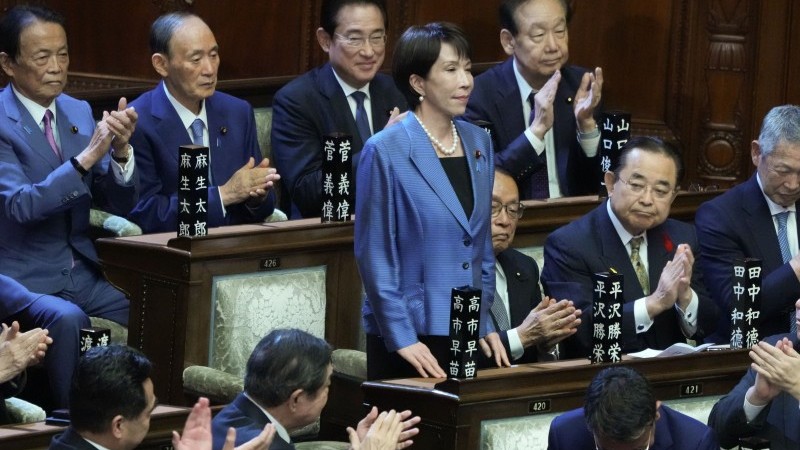Report on United States Counter-Terrorism Measures and Their Implications for Sustainable Development Goal 16
Introduction: National Security and the Framework of SDG 16
Recent executive actions within the United States, including an executive order designating “Antifa” as a “Domestic Terrorist Organization” and a subsequent National Security Presidential Memorandum on “Countering Domestic Terrorism and Organized Political Violence,” highlight a national strategy focused on organizations perceived as being on the political left. These measures, while aimed at reducing violence and ensuring security in line with Target 16.1 of the Sustainable Development Goals (SDGs), raise significant questions regarding the promotion of justice, the rule of law, and the strength of institutions, as outlined in SDG 16: Peace, Justice, and Strong Institutions. This report analyzes the legal frameworks for terrorist designations and their potential consequences for civil society, institutional accountability, and access to justice.
Governmental Actions and Institutional Frameworks
A series of high-level actions underscore the U.S. government’s focus on countering perceived domestic threats. These actions challenge the principles of effective, accountable, and transparent institutions (SDG Target 16.6) by employing broad definitions and authorities.
- An executive order was issued designating “Antifa” as a Domestic Terrorist Organization.
- A National Security Presidential Memorandum was released to create a national strategy for investigating and disrupting networks that foment political violence.
- A White House roundtable was convened to discuss violence attributed to Antifa, during which the President directed the Secretary of State to consider a Foreign Terrorist Organization (FTO) designation.
These developments suggest that entities associated with progressive causes, including non-profit foundations and for-profit businesses, may face government actions that could impede their contributions to various SDGs. Such actions could include asset blocking, revocation of tax-exempt status, and criminal investigations, impacting the operational capacity of key partners for sustainable development (SDG 17).
Legal Mechanisms for Terrorist Designation
The U.S. government can employ several legal regimes to designate organizations as terrorist entities. The application of these frameworks is central to upholding the rule of law and ensuring equal access to justice for all (SDG Target 16.3).
Foreign Terrorist Organization (FTO) Designation
The Secretary of State is authorized to designate an FTO under the Immigration and Nationality Act if three criteria are met:
- The organization is a foreign entity.
- The organization engages in, or has the capability and intent to engage in, “terrorist activity” or “terrorism.”
- The organization’s activities threaten the security of U.S. nationals or the national security of the United States.
Specially Designated Global Terrorist (SDGT) Designation
Under the International Emergency Economic Powers Act (IEEPA) and Executive Order 13224, the Secretaries of State and Treasury can designate entities as SDGTs. An entity can be designated if it meets one of the following conditions:
- It has committed, or poses a significant risk of committing, acts of terrorism.
- It is owned or controlled by, or acts on behalf of, other designated entities.
- It provides financial, material, or technological support for acts of terrorism or designated entities.
- It is otherwise associated with designated individuals or entities.
Consequences of Designation and Impact on SDG 16
Both FTO and SDGT designations result in severe consequences that directly engage SDG 16 targets related to reducing illicit financial flows (16.4) and promoting the rule of law (16.3). While intended to combat terrorism (16.a), these measures can have far-reaching effects on designated parties and associated third parties.
Impacts on Designated Parties
- Asset Blocking: Both FTO and SDGT designations lead to the entity being placed on the Specially Designated Nationals (SDN) List. Consequently, their assets are blocked, and U.S. persons are generally prohibited from engaging in transactions with them. This aligns with efforts to curb illicit financial flows but raises due process concerns under SDG Target 16.3, particularly when applied to domestic entities.
- Travel and Immigration Restrictions: Representatives and members of a designated FTO who are non-U.S. nationals are deemed inadmissible to and removable from the United States.
Impacts on Third Parties and Civil Society
The designations carry significant risks for third-party organizations, including foundations and non-profits, potentially creating a chilling effect that undermines an inclusive and peaceful society.
- Criminal Liability for “Material Support”: Third parties can face criminal prosecution for providing “material support or resources” to a designated FTO. The broad definition of material support poses a risk for civil society organizations whose work may inadvertently intersect with designated entities, thereby threatening the partnerships essential for achieving the SDGs (SDG 17).
- Sanctions Violations: An FTO or SDGT designation enables criminal prosecutions for sanctions violations under IEEPA, with severe penalties including fines and imprisonment.
- Civil Lawsuits: The Anti-Terrorism Act (ATA) allows private civil suits against any individual or entity that aids and abets the terrorist acts of a designated FTO or SDGT, exposing foundations and non-profits to potentially costly litigation.
“Domestic Terrorist Organization” Designation and Institutional Accountability
The designation of Antifa as a “domestic terrorist organization” does not currently carry the same statutory legal consequences as an FTO or SDGT designation. However, it signals an intent to utilize executive branch powers to investigate and disrupt targeted organizations. This approach may challenge the development of effective, accountable, and transparent institutions (SDG Target 16.6) by creating legal ambiguity. The focus on reviewing the tax-exempt status of non-profits and initiating criminal investigations based on this non-statutory designation could be perceived as an attempt to influence policy through coercion, contrary to the principles of an inclusive and just society envisioned in SDG 16.
Analysis of the Article in Relation to Sustainable Development Goals
1. Which SDGs are addressed or connected to the issues highlighted in the article?
-
SDG 16: Peace, Justice and Strong Institutions
This goal is central to the article, which focuses on the legal and institutional frameworks used by a government to address domestic terrorism and political violence. The text discusses the use of executive orders, national security memoranda, and specific statutes (Immigration and Nationality Act, International Emergency Economic Powers Act) to designate organizations as terrorist entities. This directly relates to the functioning of state institutions, the application of law, and the maintenance of peace and security.
2. What specific targets under those SDGs can be identified based on the article’s content?
-
Target 16.1: Significantly reduce all forms of violence and related death rates everywhere
The article is framed around government efforts to counter “Domestic Terrorism and Organized Political Violence.” It mentions actions taken to “investigate and disrupt networks, entities and organizations that foment political violence” with the goal of intervening “before they result in violent political acts.” This directly addresses the aim of reducing violence.
-
Target 16.3: Promote the rule of law at the national and international levels and ensure equal access to justice for all
The article extensively details the legal mechanisms for terrorist designations, such as the criteria for Foreign Terrorist Organization (FTO) and Specially Designated Global Terrorist (SDGT) status. It also notes the potential for legal challenges, referencing that “designations of US persons (meaning both entities and individuals) as SDGTs are likely to face significant challenges in court” and that courts have raised “constitutional due process concerns.” This highlights the interplay between national security actions and the rule of law.
-
Target 16.6: Develop effective, accountable and transparent institutions at all levels
The article describes the actions of specific government institutions, including the President, the Secretary of State, and the Secretary of the Treasury, in implementing national security policy. The issuance of an “executive order,” a “National Security Presidential Memorandum,” and a “fact sheet” are all examples of institutional actions. The entire piece is an analysis of how these institutions are using their authority.
-
Target 16.a: Strengthen relevant national institutions… to prevent violence and combat terrorism and crime
The article explicitly mentions the creation of a “national strategy to investigate and disrupt networks” and the use of “additional national security authorities, including counterterrorism authorities, and resources” to combat perceived threats. These actions represent an effort to strengthen the capacity of national institutions to prevent violence and fight terrorism, which is the core of this target.
3. Are there any indicators mentioned or implied in the article that can be used to measure progress towards the identified targets?
-
Indicators for Target 16.1 (Reduce violence)
The article implies that a key measure of the problem is the occurrence of “violent act or an act dangerous to human life, property, or infrastructure” and “violent political acts.” Therefore, an implied indicator would be the number of incidents of political violence and domestic terrorism that the government is seeking to reduce.
-
Indicators for Target 16.3 (Rule of law)
The article points to several legal actions that can be quantified. Implied indicators include:
- The number of criminal investigations and prosecutions for providing “material support” to designated organizations or for sanctions violations.
- The number of private civil suits filed under the Anti-Terrorism Act (ATA).
- The number of legal challenges and court cases questioning the constitutionality and due process of domestic designations.
-
Indicators for Target 16.6 (Effective institutions)
The effectiveness and activity of institutions are demonstrated through their official actions. Implied indicators include:
- The number of organizations designated as FTOs, SDGTs, or “Domestic Terrorist Organizations.”
- The number of executive orders and presidential memoranda issued related to national security and domestic terrorism.
- The number of instances of asset blocking and revocation of tax-exempt status for designated entities.
-
Indicators for Target 16.a (Strengthen institutions)
The article mentions the development of a new strategy. A direct indicator would be the existence and implementation of a formal “national strategy to investigate and disrupt networks” that foment political violence, as ordered by the National Security Presidential Memorandum.
4. Create a table with three columns titled ‘SDGs, Targets and Indicators” to present the findings from analyzing the article. In this table, list the Sustainable Development Goals (SDGs), their corresponding targets, and the specific indicators identified in the article.
| SDGs | Targets | Indicators (Implied from the Article) |
|---|---|---|
| SDG 16: Peace, Justice and Strong Institutions | Target 16.1: Significantly reduce all forms of violence and related death rates everywhere |
|
| SDG 16: Peace, Justice and Strong Institutions | Target 16.3: Promote the rule of law at the national and international levels and ensure equal access to justice for all |
|
| SDG 16: Peace, Justice and Strong Institutions | Target 16.6: Develop effective, accountable and transparent institutions at all levels |
|
| SDG 16: Peace, Justice and Strong Institutions | Target 16.a: Strengthen relevant national institutions… to prevent violence and combat terrorism and crime |
|
Source: wilmerhale.com







